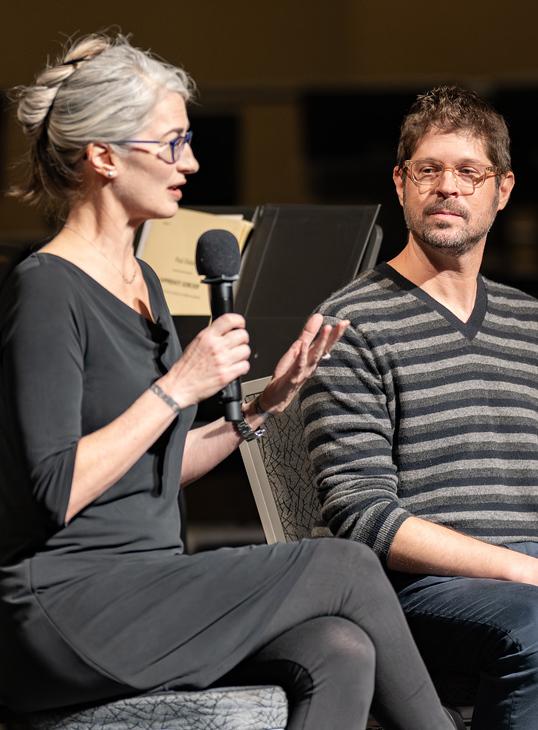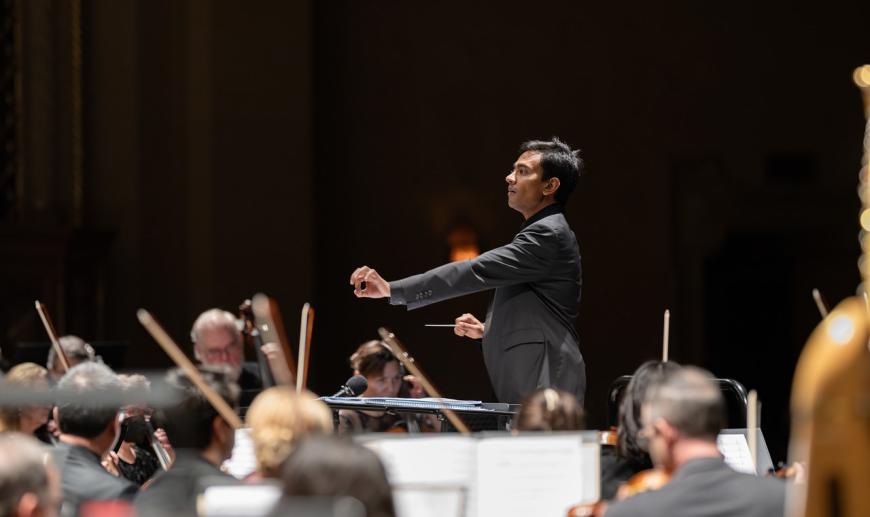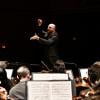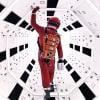
Symphony San Jose, under guest conductor Vinay Parameswaran, offered a cello concerto with a difference over the weekend. I heard the Jan. 28 performance at the California Theatre.
Automation is an experimental collaboration between composer Adam Schoenberg and AGNES (Automatic Generator Network for Excellent Songs), an AI learning algorithm pioneered by Kathryn Leonard, a computer science professor at Occidental College in Los Angeles, where Schoenberg also teaches. According to Schoenberg, AGNES is a talented composer with a sure technical sense but lacking in emotional depth.
The idea was to have the live human soloist, Yves Dhar, match wits and skills with AGNES, who appeared musically in the form of electronically processed cello (a prerecorded Dhar playing AGNES’s contributions to the score) and visually on a scrim as a hologram cellist (which resembled the Tin Woodman from The Wizard of Oz).

In a preconcert interview, Schoenberg and Leonard made the face-off sound like quite the challenge for the human, but in practice AGNES seemed mostly just to be repeating phrases after Dhar played them. These were often rising scalar passages, bringing to the event some tension, which was further ratcheted up by increasingly frantic orchestral accompaniment. Any added virtuosity in the AGNES part didn’t come across insofar as both cellos were audible over the orchestra.
After the music reached a painful orchestral climax, AGNES disappeared, and Dhar switched to a halldorophone, an electroacoustic instrument that looks a bit like a cello but sounds like a squeeze toy or a hinge badly in need of lubricant. Then, Dhar returned to his cello to accompany a peaceful orchestral conclusion in the idiom of a John Williams score for a children’s film.
For an encore, Dhar offered his own arrangement of a tango from Isaac Albéniz’s piano suite España, Op. 165.
The other three works on the program were all about technology gone wrong. John Adams compares his Short Ride in a Fast Machine to “when someone asks you to ride in a terrific sports car, and then you wish you hadn’t.” It’s not the first machine journey in classical music — there are train rides by Arthur Honegger and Heitor Villa-Lobos, among others — but it’s probably the fastest, and here it sparkled like mad.
The Sorcerer’s Apprentice by Paul Dukas, well known from its cartoon incarnation starring Mickey Mouse, is a programmatic description of an apprentice enchanting a broom to carry water for him and then finding he can’t stop it. Disaster ensues until the sorcerer steps in. The slow sections of shimmering strings in this performance served as an intense reminder that the composer was French, while colorful moments in the low winds popped out as if they were part of the Disney cartoon. It’s always gratifying to hear a pops piece from a top orchestra with the benefit of diligent rehearsal, and there’s no doubt that Symphony San Jose meets that standard.

Also sprach Zarathustra (Thus spoke Zarathustra) is Richard Strauss’s musical depiction of Friedrich Nietzsche’s book about a philosopher who is seeking the answer to the ultimate question of life, the universe, and everything (to borrow the words of a more recent philosopher). One solution he discards along the way as insufficient is science, represented by Strauss as a slow fugato. But really, Also sprach was programmed for this concert because its spectacular opening fanfare has become iconic as the motto theme for the movie 2001: A Space Odyssey — which features, among other things, a malevolent AI supercomputer.
It’s asking a lot of an audience to sit through 30 minutes of Strauss just for the sake of the opening fanfare, but it was more than worth it. Parameswaran led a spectacular performance that tumbled through contrasting moods with bravado. Only one criticism: The organ was too loud in the section representing religion, contrary to the composer’s specific instruction to keep it soft.




